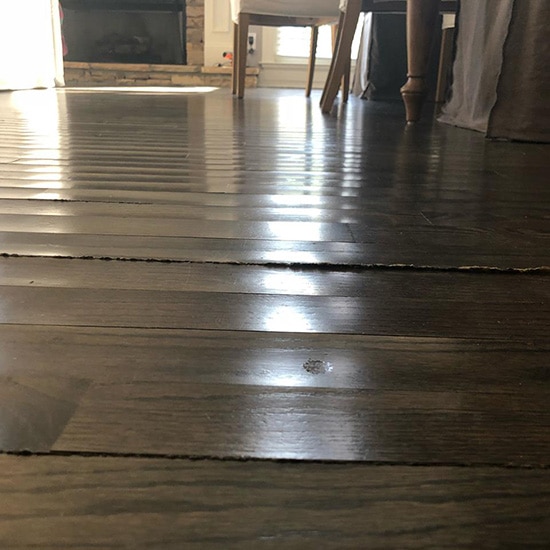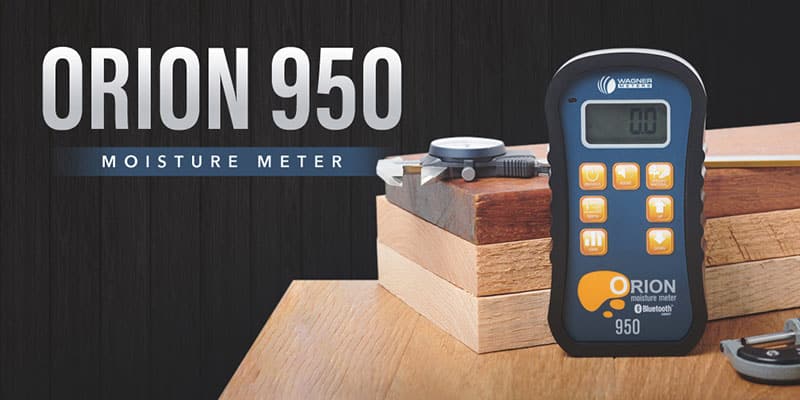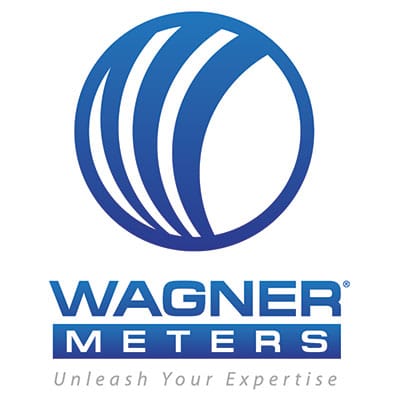Protect Your Wood’s Quality with Moisture Testing Techniques
Whether you’re a professional woodworker, the owner of a sawmill, or a wood flooring installer, you’d be dismayed if the wood you use warps after you work with it or process it.
You thought it was dry! What went wrong?
What would you do if you learned the culprit is moisture?
In this article, we’ll look at proper moisture control to maintain excellent quality in your wood so you won’t have to deal with failure from moisture again. We’ll talk about:
- Why moisture control matters
- Methods for wood moisture measurement
- Advanced techniques for moisture measurement
- Why choose Wagner Meters
Let’s start with why it’s important to control moisture.
Why Moisture Control Matters
Moisture control for your wood is incredibly important, even if it doesn’t seem like it. Ever had a board warp on you? Or split at the end? As we’ve already touched on, that’s most likely due to poor moisture control.
And moisture control begins with understanding the concept of moisture content.
Wood Moisture Content
In short, moisture content is the amount of water—or moisture—in a piece of wood, usually expressed as a percentage. The moisture content of a piece of wood needs to be within a certain range to safely use that wood. Otherwise, you risk damage to the wood and the project it’s used in.
Wood that is freshly cut from a tree is considered green and unseasoned. However, most uses for wood (such as flooring or other projects) require a moisture content below 15%, and usually below 10%, depending on the use.
Now, let’s throw a curveball:
The moisture content of wood fluctuates with changes in its environment.
You see, wood is a hygroscopic material—meaning it absorbs and releases moisture to match its environment. If the air has more moisture in it than the wood, the wood will absorb some of that moisture from the air. And vice versa.
Wood moisture content won’t stabilize until it has reached the equilibrium moisture content (EMC). At this point, it neither gains nor loses moisture as long as ambient conditions remain stable.
To let the wood reach EMC, you must acclimate it, or let it sit in its final environment until it stabilizes. If the environment itself isn’t stable—in other words, there’s poor moisture control—a host of problems can arise later on.

A warped floor from moisture damage
Problems Arising from Poor Moisture Control
When wood moisture content is not considered, many issues can come up. A big one is warping.
Warping is any deviation from flatness in a board. This includes:
- Twisting
- Bowing
- Cupping
- Crooking
Warping can render a board useless, or at least require chopping and sawing to salvage a good section. It can be a result of changes in the moisture content, or too quickly or too slowly drying the board.
Shrinking or swelling are other common problems. When a board releases moisture, it shrinks, which can cause:
- Gaps between pieces
- Cracks
- Checks
Swelling, on the other hand, happens when a board absorbs more moisture, often leading to warping.
So, the question is, how do you prevent these issues?
How to Measure and Control Moisture
The solution to the many problems mentioned above is moisture measurement. Measuring moisture allows you to know the moisture content of your wood and whether your wood has reached the EMC.
With a knowledge of the moisture content, you can plan your projects or processing accordingly and
Prevent moisture-related problems like warping, shrinking, or swelling
Ensure the longevity and quality of your project (because you’ll have prevented moisture-related problems from occurring!)
Build and maintain your reputation in your community and beyond
Here are some methods for measuring moisture in wood:
Oven-Drying
Oven-dry testing is a method to test for moisture, primarily used for research purposes.
How it works: Weigh a piece of wood and dry it until the weight no longer changes. Then weigh it again. The difference between the weights is the amount of moisture in the wood. This number can then be used to calculate the moisture content as a percentage.
This sounds like a really good idea, but it has several downsides:
- The average person or company won’t have access to the special ovens required to perform this test. They are extremely accurate and more expensive.
- The test takes time. Depending on the size of the sample you’re testing, it could take several days to dry the wood out completely. When you’re on a schedule, you don’t have time to wait that long!
- By the time the wood has dried out completely, it’s usually unusable for woodworking (not to mention you’ll probably only be able to fit small samples in your oven).
Given all these factors, oven drying isn’t practical for most people. So let’s turn to the other method: moisture meters.

The Orion 950 effortlessly takes accurate moisture measurements
Moisture Meters
A moisture meter is a handheld device that can be used on wood or another material to determine the moisture content of the wood. Usually, the meters are either pin or pinless.
Pin meters have two pins that stick into the wood and use electricity to determine moisture content. Water conducts electricity well, compared to wood, so the pins experience different amounts of resistance. The less resistance, the higher the moisture content. The more resistance, the lower the moisture content.
The only problem with pin meters comes with the pins themselves. They leave unsightly holes in the wood. Plus, they can be more difficult to use—some woods are harder than others, making pin insertion a challenge.
So the best option is a pinless meter, such as Wagner’s Orion® 950.
A pinless meter uses an electromagnetic sensor to measure moisture content. Just place the sensor pad on a flat surface of the wood, and the meter will measure the moisture content using electromagnetic waves.
The pinless meter is ideal because it won’t damage the wood and the pins don’t have the potential to snap off. You can measure quickly, multiple times, and with ease.
Beyond handheld devices, there are also larger moisture measurement systems.
Advanced Techniques for Moisture Measurement
A meter might work for a few pieces of lumber, but when you have a mill or manage large amounts of wood, a handheld meter isn’t always enough. Sometimes, you need an in-line moisture measurement system.
In-Line Moisture Measurement Systems
In-line moisture measurement systems are lifesavers when it comes to managing moisture levels during the drying process. These systems, installed on a conveyor system, measure each piece of wood as it travels past the moisture sensors. In-line systems can gather data to give a rounded, accurate depiction of the moisture content of an entire batch of lumber.
As wood is kiln-dried and run through the planer mill or down a conveyor line, an in-line moisture measurement system can take frequent measurements of wood from all kilns, storing and organizing the data if connected to data gathering software. Then, you can look at that comprehensive data to see what the average moisture content is, as well as that of each kiln load or product run.
If you’re having trouble with some pieces not drying properly, the in-line system can give a good idea as to the amount and even clue you in to which kiln isn’t doing its job. This way, you can fine-tune the kiln-drying process by extending or decreasing the drying time or changing the temperature.
In-Kiln Moisture Measurement Systems
An in-kiln moisture measurement system assists in the kiln control systems’ drying program.
Basically, it measures the moisture content as the wood is drying in the kiln. Unlike the in-line moisture measurement system, however, it’s not a comprehensive data analysis tool.
Instead, it helps the kiln operator determine when the wood in the kiln has come within the target moisture content level—and when a charge is ready to pull from the kiln.
How exactly does it do that? Well, it uses up to eight sensors placed within the kiln to measure a small fraction of the kiln load.
Why Choose Wagner Meters?
Wagner Meters has over 50 years of experience in designing reliable, accurate products. Started by Delmer Wagner, who designed a second-generation in-line moisture detector in 1965, Wagner Meters has helped fundamentally change and improve moisture detection in wood.
We continue to use cutting-edge technology to bring advanced products to you. Accuracy is one of our main focuses—and it’s important! An inaccurate reading can lead to ruined wood and projects that an accurate reading could easily help the user prevent. With this emphasis, our meters have become the most accurate on the market.
The best method for measuring moisture, then, is with a Wagner Meter. For handheld meters, our pinless Orion 950 and the L620 are advanced modes with a lot of features, designed for ease and quickness of use as well as species adjustment. The Orion 950 also has EMC calculation.
If you’re looking for an advanced in-line or in-kiln system, consider our Omega in-line system and our MC4000 in-kiln systems.
Since the beginning, supporting our customers has also been a huge priority. If you have any questions about moisture measurement or our products, we’re here to help. You can call Wagner Meters during business hours, and our professionals will provide expert advice, training, troubleshooting, and other general help in a timely and efficient manner.
We understand how important moisture control is for any serious woodworker, installer, or mill owner. Moisture has the potential for causing major damage to your wood or greatly reducing the grade of the lumber that is being produced by a mill.
By using proper measurement and control, you’re ensuring wood quality, maintaining your reputation, and saving money. In-line and in-kiln systems and handheld meters all play a vital role in this process.
So, why not get your moisture monitoring tools today? Contact us for more information!

Wagner Meters is a family-owned American business that aims to provide solutions in moisture measurement technology that will enhance the quality and value of each customer’s project. With an almost 60-year legacy of innovation, Wagner continues to be a resource for both individual craftsmen and high-performance commercial endeavors.
Last updated on March 13th, 2025



